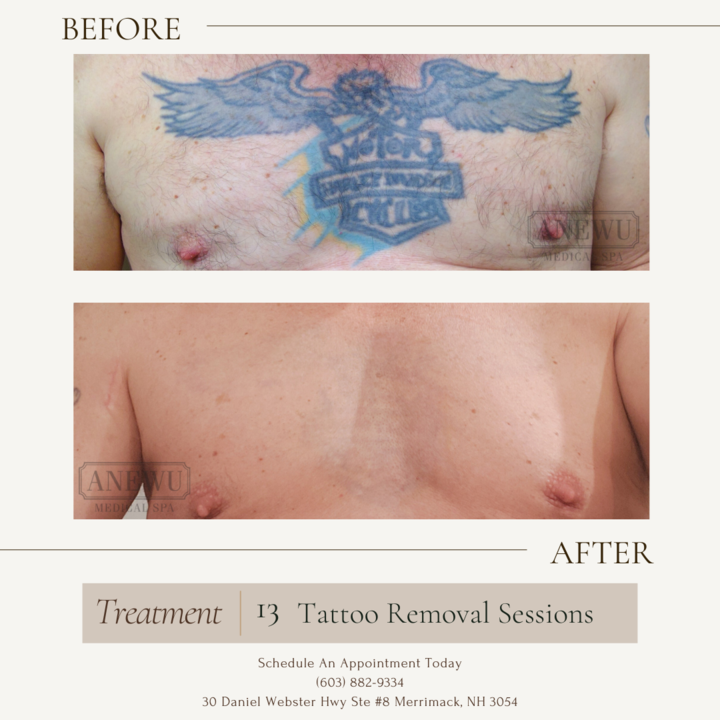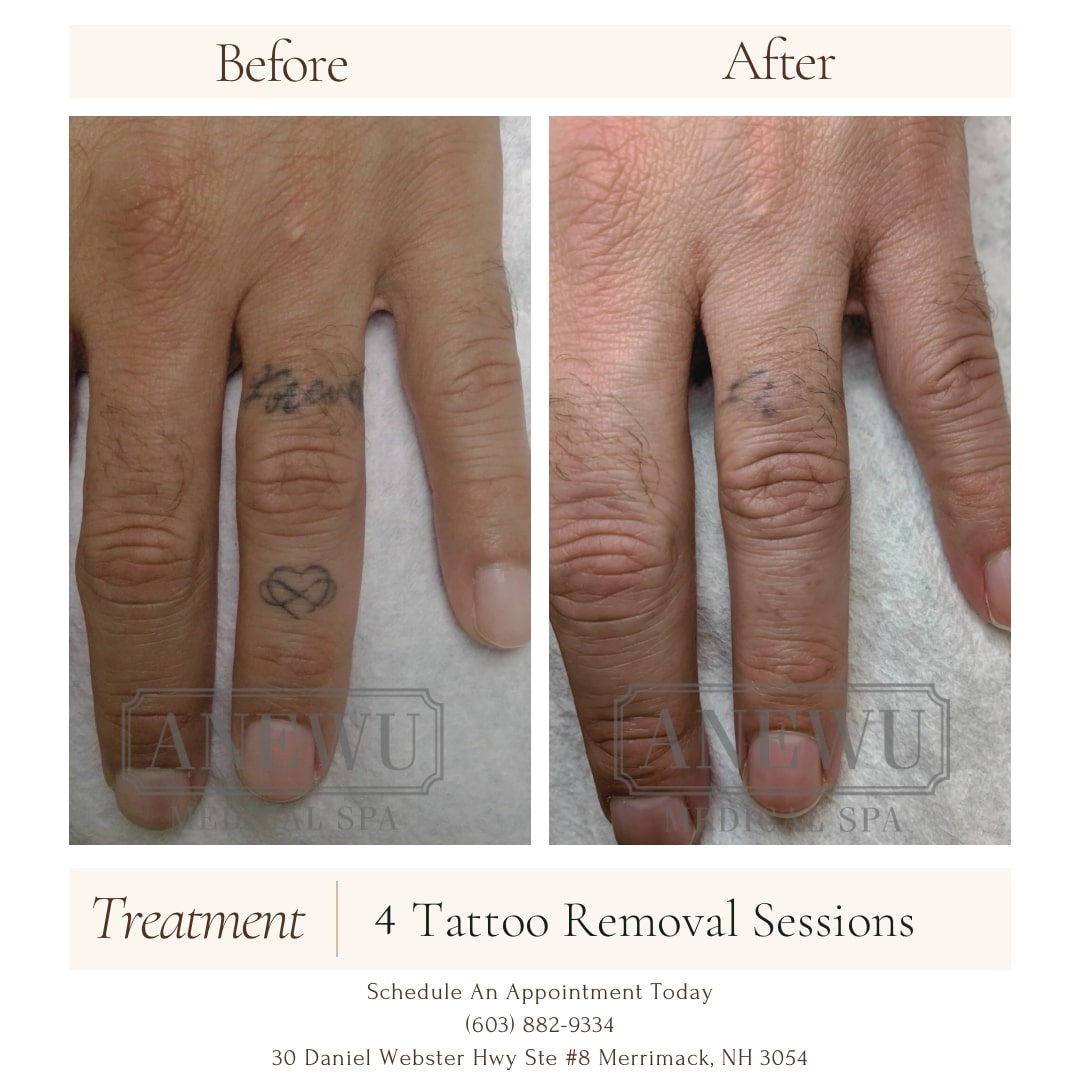ANEWU Medical Spa has been providing laser tattoo removal since 2006. Lasers emit various wavelengths of light. Each wavelength is attracted to a specific color. As laser light is emitted it is specifically attracted to the color of the ink. Therefore; multi-colored tattoos require multiple wavelengths of light to be effective. We are proud to be able to offer multi-color tattoo removal for all ink colors except yellow and white. As the energy from the laser heats up the ink it begins to break up the pigment. Over time the body dissolves the pigment and the tattoo begins to fade.
What To Expect
- Average number of treatments can be difficult to predict as it varies depending on the age and location of the ink, as well as its depth, density and composition. In general we advise 6-12 or more treatments (*). Typically “amateur” tattoos and older, already faded tattoos are easier to remove than “professional” (*).
- Treatments are recommended every 6-8 weeks (*). In some instances it may be recommended to “take a break” from treatments for several months to allow the body to break up the ink further (*).
- During the treatment it feels like a localized “hot” snapping sensation against the skin. Some people report that the level of discomfort is no worse than when they got the tattoo while others will report that it hurts more. For comfort, lidocaine may be injected prior to treatment. Topical anesthetics are not strong enough and do not penetrate deep enough to be effective. Pain is not typically reported after the treatment.
- The most commonly reported concern amongst patients is how long it takes to remove the tattoo as well as incomplete removal of the ink. It is common to have a slight haze of the tattoo remain despite an adequate number of treatments.
Side Effects
- Immediately after a treatment the tattoo may appear blanched or white with some pinpoint bleeding. Within a few minutes the tattoo returns to it’s normal color.
- Redness and swelling are common and typically last a few days.
- Blisters and scabs are expected but should be reported if they last greater than 7 days.
- It is not uncommon for pigmentation changes to occur. As the ink is removed it is common to unveil skin cells that have become depigmented due to aging, resulting in white spots. In other instances the removal of the ink will lead to some brown staining of the skin due to the composition of the ink. Please refer to our before and after images which depict common and realistic laser tattoo removal results. In other instances pigmentation changes can be an unexpected effect. To minimize this we do not treat tanned or dark skinned individuals and test patch skin types that are predisposed to pigmentation changes.
- Ink that contains iron may shatter and the tattoo may appear like broken glass. If this occurs treatments should be discontinued to prevent scarring of the skin. Some inks contain other types of metals and when lasered the color will change, for instance from brown to green. For this reason we do not remove permanent make-up.
- In areas where the ink was deposited more heavily it is not uncommon to see some skin changes such as some slight pinpoint holes or faint wrinkling of the skin. It is not recommended to discontinue treatments unless if this side effect is bothersome to you. This is a normal and in most cases an unavoidable and possibly a long term result of treatment.
- If the tattooed skin appears raised prior to treatment it is quite possible that the raised skin may not return to it’s pre-tattooed state of being flush with the neighboring skin despite the ink being removed. Therefore removal of the ink may give the inverse appearance of being “branded.” This is not as a result of the laser treatments but rather as a result of the skin having been tattooed.
Contraindications To Treatment
- Accutane should not be used within 6 months prior to laser treatments.
- History of keloids.
- Open wounds or rash present at the treatment site.
How To Prepare For Your Treatment
- Ensure that the area being treated is free from tan or a residual tan. If self tanner is present in the treatment area, please remove it with Head & Shoulders shampoo prior to arrival.
- The tattoo should be a minimum of 6 months old.
- All moisturizers and make-up in the treatment area should be removed prior to treatment.
- If you have a history of cold sores, herpes, or shingles in the area being treated you may need to start an antiviral medication to reduce the likelihood of recurrence.
- Tattoo bleaching agents such as Wrecking Balm should be discontinued 3 months prior to treatment.
What To Do After Your Treatment
- It is common to have mild redness and swelling after the treatment and for small scabs or blisters to form within the first few days.
- Ice may be applied for 15-30 minutes after treatment.
- Cleanse the area twice daily with soap and water and keep the area covered with a clean dressing and bacitracin until the area is scabbed up. If blisters are present do not open them.
- Refrain from tanning for the duration of your treatments and for two weeks after your final treatment. If you intend on tanning you may do so two weeks after your final treatment however you may not return for a treatment until your skin as returned to its baseline color. If you are uncertain if you have a residual tan please call the office as a test patch may need to performed prior to resuming treatments.
- If you experience hyper or hypo-pigmentation changes or “shattering” of the tattoo or any other adverse effect please contact us at 603-882-9334.
Click here for our scheduling and payment policies


